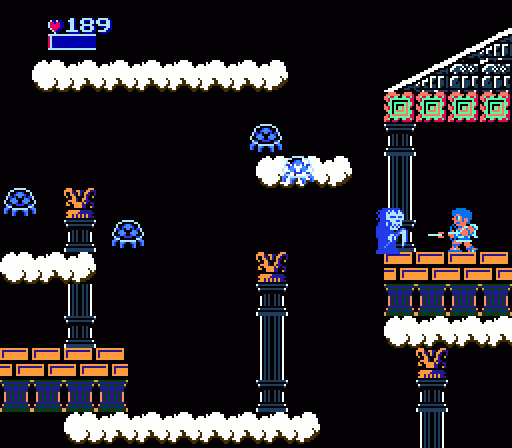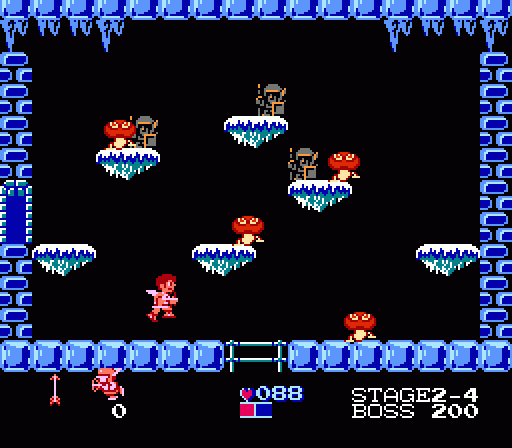Before I venture any further into The Anatomy of Metroid, its sibling micro-series Kid Icarus requires a look. The original games in each respective series shared a certain amount of overlap, as the Metroid staff helped put the wraps on Kid Icarus after shipping their own project.
Despite have been developed and released shortly after Metroid, Kid Icarus feels more like an earlier, transitional game that should have come between Super Mario Bros. and Metroid. It’s rougher around the edges, more linear, more limited. The control scheme is weird, the balance is wackily lopsided, and the systems are far simpler. Kid Icarus feels like a step backward for Nintendo R&D1.
And yet, there’s this manic glimmer of genius in the game. Not only does it have a shop system, similar to Capcom arcade titles of the era, you can also potentially find a credit card with which to purchase goods for which you can’t currently afford (and which puts you in debt until you pay back the cash you borrowed). It features the rudiments of an experience system. It contains multiple endings. And it includes some coy references to Metroid, too.

Fundamentally, Kid Icarus’ basic play resembles Metroid‘s quite a bit. Protagonist Pit begins the game using a weak weapon with pitiful range, which can be powered up considerably. He runs and jumps, traversing horizontal planes, vertical shafts, and complex labyrinths. He gains more health and has an “alternate fire” mode that helps supplement his strength during boss encounters. However, the two games differ considerably in the execution. Pit’s power-ups are strictly progressive, and they don’t unlock any aspects of the environment; they simply make him more powerful in combat. The different traits of the world design — horizontal, vertical, labyrinthine — are presented separately rather than in unison.
There’s very little exploration to be done in Kid Icarus. Only three stages of the adventure (the palaces at the end of each world) break from the linear format, taking on a form reminiscent of Zelda‘s dungeons: Single-screen mazes filled with monsters. But there are no puzzles to speak of, only enemies to fight and paths to determine. And in the end, it proves to be a fairly small adventure with a mere 13 levels to conquer. Once you’re over the initial learning hump, the remainder of the quest unravels quickly.

To me, the real sign of Kid Icarus‘ intermediate game design nature is found in the presence of its score indicator. Pit earns points for his performance in a stage, with values (both positive and negative) assigned to every action you complete — much like arcade games of old. But your score doesn’t appear during the action; it only tallies up at the end of a stage, and the points you earn are treated as experience. For every milestone you reach, Pit permanently gains extra maximum health. Furthermore, certain target scores cause a god to manifest in otherwise empty chambers to grant Pit a stronger weapon. It was one of the first video games to treat high scores as something besides an opportunity for bragging rights — though originally they served that purpose as well, since the Japanese edition of the game kept a record of the scores associated with different players’ completed adventures.
Much about Kid Icarus seems either strange or simply under-designed. Certainly it didn’t offer nearly as much innovation and cleverness as contemporaries like Metroid, Zelda, and Super Mario Bros., which is why those franchises have endured through the years with numerous sequels while Kid Icarus has seen all of two follow-ups; Pit is usually seen more as a Smash Bros. character now than as the star of his own adventures. Even so, this rough-cut gem offers a few facets worthy of discussion.
I was terrified to see the Eggplant Wizard. Not because of loss of life, but loss of time getting to the hospital to remove that vile affliction. Also, I wish some one would fix the little annoyances of this game and re-release it. It’s not a bad game and interesting in some of its archaic elements, but pressing down to avoid perilous objects only to fall to my doom is bad game design in any era.
Raymond, have you played the 3D Classics version? It doesn’t iron over every flaw, but it improves jumping and that alone makes it vastly more entertaining than the NES original.
I must say, these Anatomy of a Game write-ups are quite inspiring. I was inspired to finally work my way through The Legend of Zelda and Metroid, now I want to play through Kid Icarus. If only EOU was not so addictive.
Glad to see this series - Kid Icarus was one of the “classic: NES games that I never played. Maybe it’s time to fire up the old 3D Classics version on my 3DS and play along.
I hope that your NC move went well!
Now that you mention it, I forgot that they did that. One more reason for me to finally pick up a 3DS XL. Thanks for the reminder.